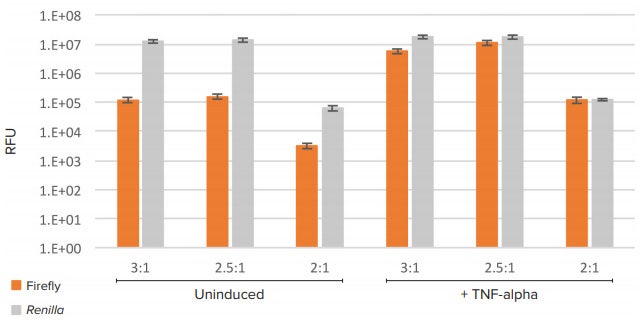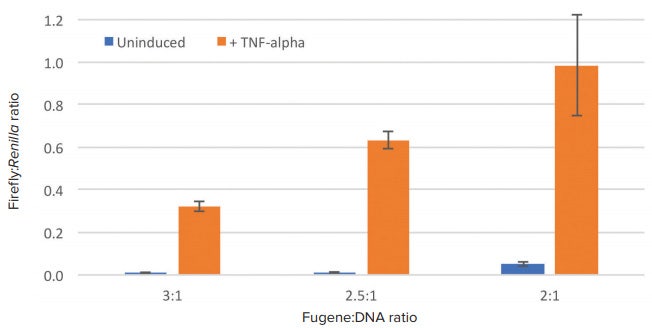
Application Note
Monitor NF-κB activation with a sensitive dual luciferase reporter assay on the SpectraMax iD5
- Detect multiplexed luciferase assay results with a sensitive dual reporter assay
- Improve accuracy of results by normalizing reporter expression to a control
- Expedite results with a preconfigured SoftMax Pro Software protocol
Introduction
Cathy Olsen, PhD | Sr. Applications Scientist | Molecular Devices
Reporter genes are valuable tools for studying gene expression, serving as surrogates for genes involved in various signaling pathways and disease conditions. Luciferases are the most common reporter genes, as they are easily detectable using luminometers or luminescence microplate readers, and the low luminescent background present in cells enables high assay sensitivity. Firefly luciferase is typically used as a readout for expression of a gene of interest. Luciferase from the sea pansy Renilla reniformis is often used in multiplexed luciferase assays as a second reporter to normalize for transfection efficiency, cell viability, and other factors that may vary among assay samples.
The SpectraMax® DuoLuc™ Reporter Assay Kit enables sensitive quantitation of both firefly and Renilla luciferases in mammalian cells. Serial injection of two optimized detection reagents allows the luciferases to be assayed in the same microplate well. The result is a two-signal assay system that enables normalization of experimental signal (firefly luciferase) to a constitutively expressed control (Renilla luciferase). The assay is fully optimized for use with the SpectraMax® iD5 Multi-Mode Microplate Reader plus injector system with SmartInject™ Technology
Here we show how the DuoLuc reporter assay and SpectraMax iD5 reader are used to detect nuclear factor-κB (NF-κB) activation in a mammalian cell model. NF-κB is a ‘master regulator’ of gene expression for many cellular processes including inflammation, immunity, differentiation, proliferation, and apoptosis. Signaling molecules like tumor necrosis factor α (TNF-α) stimulate cellular pathways that degrade inhibitors of NF-κB and free it to enter the nucleus, where it can regulate hundreds of different genes (Figure 1).1 Because disruption of NF-κB signaling is implicated in a long list of diseases—multiple sclerosis, diabetes, and Alzheimer’s, to name just a few— tools that advance our understanding of NF-κB pathways are essential.

Figure 1. NF-KB signaling pathway. TNF-α activates a signal cascade resulting in degradation of the NF-KB inhibitor IKB and release of NF-KB transcription factor to the nucleus
Materials
- SpectraMax DuoLuc Reporter Assay Kit (Molecular Devices cat. #R8361)
- HEK 293 cells (ATCC cat. #CRL-1573)
- Culture medium: DMEM + 10% fetal bovine serum + penicillin/streptomycin
- pGL4.32[luc2P/NF-κB-RE/Hygro] firefly luciferase vector (Promega cat. #E849A)
- pGL4.75[hRluc/CMV] Renilla luciferase expression vector (Promega cat. #E693A)
- FuGENE HD Transfection Reagent (Promega cat. #E2311)
- Opti-MEM Reduced Serum Medium (ThermoFisher Scientific cat. #31985062)
- 96-well clear-bottom white polystyrene TC-treated microplates (Corning cat. #3610)
- TNF-α 10 μg/mL solution in PBS + 1 mg/mL BSA (Sigma cat. #T0157)
- BrightMax white sealing film (Excel Scientific cat. #WT-50)
- SpectraMax iD5 Multi-Mode Microplate Reader
- Injector system with SmartInject Technology
Methods
Cell seeding and transfection
HEK 293 cells at 80% confluency were harvested by trypsinization and dispensed into wells of a 96-well clearbottom white microplate at 15,000 cells per well. When cells reached greater than 50% confluency, they were co-transfected with NF-κB-RE firefly luciferase and Renilla control vectors using three different ratios of FuGENE to amount of DNA (Table 1). Cells were placed in a tissue culture incubator at 37°C and allowed to recover for 24 hours.
Table 1. Volumes of transfection reagent and amount of DNA for different reagent:DNA ratios.
Induction with TNF-α
Induction solution was prepared by diluting the 10 μg/mL TNF-α solution to 20 ng/mL in culture medium. Medium alone was used as control solution. Medium was removed from wells to be treated, and 100 μL of either control or induction solution was added to each well. The plate was returned to the incubator and induced for seven hours.
Preparation of cell lysates
Medium was removed from the treated wells, and cells were washed once with PBS. Passive Lysis Buffer was warmed to room temperature, and 20 μL was added to each well. Cells were lysed with gentle shaking at room temperature for 15 minutes. A solid white plate seal was applied to the bottom of the plate to maximize luminescent assay signal.
Luciferase assay setup
All kit components were thawed to room temperature. Firefly Substrate was reconstituted by adding 220 μL of water to one vial containing 2.2 mg of lyophilized substrate. Aquaphile coelenterazine was reconstituted by adding 220 μL of water to one vial containing 440 μg of lyophilized substrate.
Firefly working solution was prepared by diluting firefly substrate 1:50 in Firefly Assay Buffer. Renilla working solution was prepared by diluting Aquaphile coelenterazine 1:50 in Renilla Assay Buffer. For one 96-well plate, 11 mL of each working solution was made by adding 220 μL of its respective substrate. A preconfigured protocol in SoftMax® Pro Software was used to run the assay and analyze the results with the following parameters:
- Use injector 1 to add 100 μL of firefly working solution to the well.
- Delay for 2 seconds to allow the reaction to develop.
- Measure firefly luminescence with an integration time of 5 seconds.
- Use injector 2 to add 100 μL of Renilla working solution to the well.
- Delay for 2 seconds to allow the reaction to develop.
- Measure Renilla luminescence with an integration time of 5 seconds.
- For each assay well, normalize the RLU value of the first measurement (firefly luciferase) to that of the second (Renilla luciferase).
The SpectraMax iD5 injector system with SmartInject Technology shakes the assay plate during reagent injection to ensure complete reagent mixing and maximum signal for both firefly and Renilla luciferases.
Results
All transfection conditions tested resulted in high levels of Renilla luciferase that changed very little in response to induction, and firefly luciferase levels that increased greatly with the addition of the cytokine TNF-α (Figure 2). Overall, luciferase expression was lower with the 2:1 reagent:DNA ratio than with the other ratios tested.

Figure 2. Raw luminescence data. Values are shown for uninduced and TNF-a-induced cells for each transfection condition (reagent:DNA ratio). N=9 replicates for each test condition.>
Normalizing the firefly signal to that of Renilla revealed high levels of induction for all three transfection conditions (Figure 3). While the magnitude of the normalized ratios was lower for the 3:1 and 2.5:1 tests, the fold induction was greater. Table 2 shows the fold induction values observed for each test condition. The best fold induction was obtained using a 2.5:1 ratio of reagent:DNA

Figure 3. Normalized luciferase results. Firefly RLU values were normalized to Renilla values.
Transfection condition(Reagent:DNA)
I
Fold induction(Induced/uninduced
)
Table 2. Fold induction values for different transfection conditions. The best induction was achieved with a 2.5:1 ratio of transfection reagent:DNA.
Conclusion
Robust induction of the NF-κB response element by TNF-α in HEK 293 cells was demonstrated using the DuoLuc reporter assay. Because the assay is sensitive for both firefly and Renilla luciferases, high signals for both were generated. The normalized ratios revealed a 54-fold induction of the NF-κB response element by TNF-α with the best of three transfection conditions tested.
The SpectraMax DuoLuc reporter assay has been performance optimized on the SpectraMax iD5 reader with SmartInject Technology. With a preconfigured protocol to simplify data acquisition and analysis, SoftMax Pro Software completes this total solution for fast, sensitive, and reliable dual luciferase reporter assay results.
Reference
- Oeckinghaus, A and Ghosh, S. The NF-κB Family of Transcription Factors and Its Regulation. Cold Spring Harb Perspect Biol. 2009 Oct; 1(4): a000034.